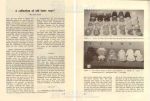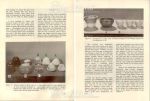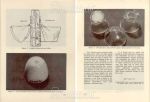We've tried to ensure the information displayed here is as accurate as possible. Should there be any inaccuracies, we would be grateful if you could let us know at info@ipohworld.org . All images and content are copyright.
(Please click on the thumbnail for a bigger image.)
An Article From The Planter Magazine - A Collection Of Old Latex Cups – Volume 59 No. 687, June 1983




The images read left to right, top to bottom.
This article was originally published in the Socfin Bulletin, a restricted circulation newsletter. It is based on the author’s own collection of Latex Collection Cups that he gathered while working in the rubber industry.
The article leads off by reminding the reader of the vast changes that have taken place in the industry over the past 100 years, but laments that there is very little record of the types and styles of the latex cup. He then launches into quite detailed descriptions of the various cups which have come to his attention and into his collection, referring to the photographs included in the article.
He covers the different forms (materials) of the cups including: porcelain; aluminium; glass; earthen glazed ware; and plastic, noting that glass remains popular at the time of writing, rather than plastic which dirties easily (contaminating the latex) and floats away easily in floods. He then embarks on shapes, and introduces these by pointing out the ones shaped like a female breast, complete with nipple (in porcelain or glass) about which he cannot offer a technical solution as to the reason behind the design. Nonetheless he does remark (facetiously?) that perhaps they were in this shape to stop the estate workers taking them home as ornaments as they cannot stand upright. Continuing with shapes, he identifies four more: a drinking glass; a cone shaped cup with an oval base (glass and plastic); a bowl (earthen glazed); and a cone shaped cup with a flat base (earthen glazed or plastic).
These artifacts also come in a range of sizes for as yield of latex have increased with improved cultivation, clones and stimulants, larger cups have been needed. The earliest cups held only 5 ounces of latex but today 20 ounces is the norm.
Turning to the age of the cups, the author makes it quite clear that this is difficult to determine, but refers to a 1921 article by Mr R M Latham, a well-known planter from Teluk Anson (now Teluk Intan) which includes a sketch showing both breast-shape and porcelain cups. He therefore concludes that these have therefore probably been in use since the very beginnings of the industry. He also refers to company names being embossed into the bottom of glass cups and etched into the sides of porcelain cups from much earlier than the 1920s, one even one bearing the chop of the Singapore tiger.
The article concludes by suggesting that old cups may well be found buried in the ground and hopes that the article has been thought-provoking and useful as a reference.
To view the Patent sketch and more about Latham’s Spout and Cup Holder, click here.
To view an image of an H & C Yellow Glass Latex Cup in our collection, click here.
To view an image of Two Dunlop Yellow Glass Latex Cups in our collection, click here.
To view an image of Two Earthenware Glazed Latex Cups in our collection, click here.
To view an image of Two Old Pottery, Triangular, Latex Cups in our collection, click here.
To view an image of Two White China Latex Cups in our collection, click here.
To view an image of Two White, Breast-Shaped, Porcelain 'Nipple' Latex Cups in our collection, click here.